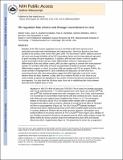Rb regulates fate choice and lineage commitment in vivo
Author(s)
Calo, Eliezer; Quintero-Estades, Jose A.; Danielian, Paul S.; Nedelcu, Simona; Berman, Seth D.; Lees, Jacqueline; ... Show more Show less
DownloadLees_Rb regulates.pdf (3.523Mb)
OPEN_ACCESS_POLICY
Open Access Policy
Creative Commons Attribution-Noncommercial-Share Alike
Terms of use
Metadata
Show full item recordAbstract
Mutation of the retinoblastoma gene (RB1) tumour suppressor occurs in one-third of all human tumours and is particularly associated with retinoblastoma and osteosarcoma[superscript 1]. Numerous functions have been ascribed to the product of the human RB1 gene, the retinoblastoma protein (pRb). The best known is pRb’s ability to promote cell-cycle exit through inhibition of the E2F transcription factors and the transcriptional repression of genes encoding cell-cycle regulators[superscript 1]. In addition, pRb has been shown in vitro to regulate several transcription factors that are master differentiation inducers[superscript 2]. Depending on the differentiation factor and cellular context, pRb can either suppress or promote their transcriptional activity. For example, pRb binds to Runx2 and potentiates its ability to promote osteogenic differentiation in vitro[superscript 3]. In contrast, pRb acts with E2F to suppress peroxisome proliferator-activated receptor γ subunit (PPAR-γ), the master activator of adipogenesis[superscript 4, 5]. Because osteoblasts and adipocytes can both arise from mesenchymal stem cells, these observations suggest that pRb might play a role in the choice between these two fates. However, so far, there is no evidence for this in vivo. Here we use mouse models to address this hypothesis in mesenchymal tissue development and tumorigenesis. Our data show that Rb status plays a key role in establishing fate choice between bone and brown adipose tissue in vivo.
Description
February 1, 2011
Date issued
2010-08Department
Massachusetts Institute of Technology. Department of Biology; Koch Institute for Integrative Cancer Research at MITJournal
Nature
Publisher
Nature Publishing Group
Citation
Calo, Eliezer et al. “Rb Regulates Fate Choice and Lineage Commitment in Vivo.” Nature 466.7310 (2010): 1110–1114.
Version: Author's final manuscript
ISSN
1476-4687
0028-0836